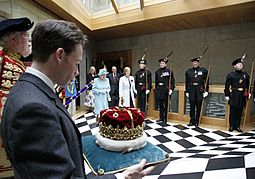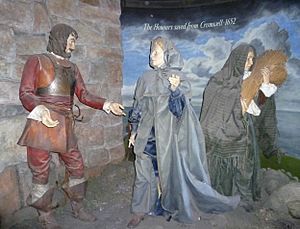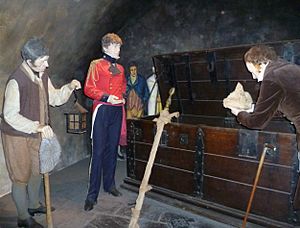Honours of Scotland facts for kids
Quick facts for kids Honours of Scotland |
|
|---|---|

The crown at the Opening of the Scottish Parliament in 2011
|
|
| Overview | |
| Country | Scotland |
| Location | Crown Room at Edinburgh Castle |
| Size | 3 objects:
|
| Owner | Commissioners for the Keeping of the Regalia |
| Managers | Historic Environment Scotland |
The Honours of Scotland, also known as the Scottish Crown Jewels, are a very old and special collection of royal items. They were made in the 1400s and 1500s. These jewels are the oldest set of crown jewels still existing in the British Isles.
These important items were used when Scottish kings and queens were crowned. This happened from Mary, Queen of Scots in 1543 until Charles II in 1651. The Honours also showed that new laws were approved in the Scottish Parliament. This continued until 1707, when Scotland and England joined together under one parliament. After that, the Honours were locked away in a chest. The English Crown Jewels were then used by British monarchs.
The Scottish Honours were found again in 1818. Since then, they have been on public display at Edinburgh Castle. They have been used for big events, like when King George IV visited Scotland in 1822. They were also used when Elizabeth II visited in 1953. When the Scottish Parliament started again in 1999, the Honours were used once more to approve new laws.
There are three main parts of the Honours of Scotland: the crown, the sceptre, and the Sword of State. The gold crown was made in Scotland. The sceptre and sword were gifts from the Pope in Italy. These items also appear on the royal coat of arms of Scotland. On this symbol, a red lion holds the sword and sceptre and wears the crown. Other royal items like robes, spurs, and a ring were once part of the collection. Queens also had their own crowns, but none of these have survived.
Some other special items, called the secondary Honours, were added later. These include a silver wand, three special badges, and a ring that belonged to King James VII. These were added in 1830. A necklace with a locket and pendant was given to Scotland in 1939.
Contents
A Look Back in Time
Early Royal Symbols
Kings in Scotland have used special royal items for a very long time. This goes back to the Middle Ages when Britain became Christian. One of the first pictures of a Scottish king with his royal symbols shows King Edgar. He ruled from 1097 to 1107. In this picture, he wears a crown and holds a sword and a sceptre. His son, Alexander I, is shown with an orb. This was a symbol of a king's power from God, but it wasn't a real item in the Scottish Honours.
By the time of King John Balliol, the royal items included a crown, sceptre, sword, and ring. In 1296, the English army invaded Scotland. They captured these royal items and the Stone of Scone. The Stone of Scone was used for crowning Scottish kings. Both were taken south to London.
New items were made for future coronations. Over time, these were replaced with the Honours we see today. The current crown was made in Scotland by John Mosman. The sword and sceptre were made in Italy and given as gifts by the Pope. A special crown was made for Mary of Guise, wife of King James V, in 1539. This crown is no longer with the Honours. The main royal items were first used together by Mary, Queen of Scots in 1543. Later, they showed the king's power in the Scottish Parliament. Laws were approved when the king or his representative touched them with the royal sceptre.
Hidden Away and Found Again

In 1633, spurs (symbols of knighthood) were given to Charles I at his Scottish coronation. These spurs and his coronation robes are now lost. The Honours were last used for a coronation in 1651 by Charles II. His father, Charles I, had been removed from power and executed. The English Parliament ordered almost all the English Crown Jewels to be melted down.
However, the Honours of Scotland were hidden. First, they were kept in Dunnottar Castle. This castle was later attacked by an army, but the Honours were secretly taken out. Then, they were hidden under the floor of Kinneff Parish Church. They were found again in 1660 when the monarchy was brought back. Even though they were found, the Honours were not used to crown Scottish kings after Charles II.
Until 1707, when Scotland and England joined to form Great Britain, the Honours of Scotland were brought to the Scottish Parliament meetings. They represented the king, who lived in England since 1603. After the two parliaments joined, the new British Parliament met in London. The Honours of Scotland no longer had a role there. So, they were locked away in a chest at Edinburgh Castle.
Back in the Spotlight
The Honours stayed hidden and almost forgotten until 1818. The future King George IV, who was then Prince Regent, gave permission for them to be found. On February 4, historian Walter Scott and other officials broke down a wall in the old Crown Room at Edinburgh Castle. They thought the chest might be empty. But they were very happy to find the crown, sceptre, and sword exactly as they had been left 111 years before!
A royal flag was raised above Edinburgh Castle to celebrate this moment. People cheered with excitement, and crowds gathered outside the castle to hear the news. On May 26, 1819, the Honours were put on public display in the Crown Room. They were guarded by two soldiers from the Battle of Waterloo.
King George IV was crowned in 1821. His visit to Scotland the next year was the first by a king since 1651. On August 12, 1822, the Honours were carried in a parade to the Palace of Holyroodhouse. There was a party-like feeling, with people lining the streets. Three days later, the king arrived and touched the royal items as a symbol. Before leaving a week later, he took part in another parade back to the Castle. The Honours stayed there until the 1900s.
Modern Use
In 1911, the sword was carried in front of King George V. This was for the opening of the Thistle Chapel in St Giles' Cathedral in Edinburgh. It was the first time any of the items had left Edinburgh Castle since 1822. During World War II, the Honours were hidden at the Castle. This was done because people worried they might be lost if the UK was invaded. The crown and some other jewels were buried under a bathroom floor. The sceptre, sword, and wand were hidden inside a wall. Only a few top officials knew where they were.
In 1953, the Honours were shown to the newly crowned Elizabeth II. This was at a special service in St Giles' Cathedral. In 1996, the Stone of Scone was returned to Scotland. It was also placed in the Crown Room with the Honours. During building work in the 1990s, the Honours were kept safely in a bank in Edinburgh.
The Crown of Scotland was present in May 1999. This was for the first meeting of the new Scottish Parliament. It was carried on a cushion because it was too delicate for the Queen to wear. The crown was also present in October 2004 for the opening of the new Scottish Parliament Building. It is still used at the opening ceremonies of each new session of the Scottish Parliament. In 2018, plans were announced to update the Honours exhibition.
The Crown, Sceptre, and Sword
The Crown
We don't know exactly when the first Crown of Scotland was made. But we can see what it looked like before 1540 in a painting of King James IV. This painting is in a special book made for his wedding in 1503. In 1532, King James V added arches to the crown. This made it an "imperial crown." This showed that the king believed he was the ruler of his own land, answerable only to God.
In 1540, the bottom part of the crown was melted down and remade by a goldsmith named John Mosman. He added 22 new gemstones to the original 20. He also added more gold. King James V first wore it for his wife's coronation that same year. The crown weighs about 1.6 kilograms (3.5 pounds). Its base has alternating fleurs-de-lis (a lily symbol) and cross symbols. Two gold arches from the old crown are on top. These hold a blue globe with stars, representing the night sky. On top of the globe is a cross with black enamel, pearls, and a large amethyst. The velvet cap inside the crown was originally purple. It was changed to red by King James VII and the current cap is from 1993. Four gold decorations with a large pearl are attached to the cap between the arches.
The Sceptre
The Sceptre of Scotland was a gift from Pope Alexander VI to King James IV. It was given in either 1491 or 1494. It was later changed and made longer in 1536. The sceptre is made of silver gilt (silver covered in gold). It has a polished rock at the top. The sceptre has strange carvings and Christian symbols. You can see stylized dolphins (symbols of the Church) on the head of the rod. There are also images of the Virgin Mary holding baby Christ, Saint James the Great, and Saint Andrew holding a saltire (a diagonal cross).
The Sword of State
The Sword of State of Scotland was also a gift from the Pope. Pope Julius II gave it to King James IV in 1507. It was made by Domenico da Sutri. This new sword replaced an older one made in 1502. The blade has designs etched into it. It is 99 centimeters (3.2 feet) long. It shows figures of Saint Peter and Saint Paul, and the name of Julius II. The handle is 38.7 centimeters (1.2 feet) long and is made of silver-gilt. It has carvings of oak leaves and acorns. The crossguard (the part between the blade and the handle) looks like dolphins. The sword comes with a wooden scabbard (sheath). This scabbard is covered in red velvet with silver-gilt decorations. It hangs from a belt made of silk and gold thread with a silver-gilt buckle.
Other Special Jewels
Since 1818, other ceremonial jewels have been added to the Crown Room display.
The Wand
When Walter Scott found the crown, sceptre, and sword, he also found a silver-gilt wand. It is 1 meter (3.3 feet) long. It has a crystal globe at the top with a cross on it. The wand has a wooden core. We don't know who made it or what it was used for. Its purpose is still a mystery. Walter Scott thought it might have been carried in front of a high-ranking official called the Lord High Treasurer of Scotland.
The Stewart Jewels
Four items that were taken by King James VII when he went into exile in 1688 are also displayed. These are a locket, a Great George and collar, and a ruby ring. They were returned to Britain 119 years later. King William IV gave them to Edinburgh Castle in 1830.
The St Andrew Jewel of the Order of the Thistle is a gold and silver locket. It hangs from a ribbon. Inside it is an oval piece of stone with a carved image of Saint Andrew. This carving is surrounded by 12 diamonds. On the back, it says in Latin: NEMO ME IMPUNE LACESSIT. This means "no one attacks me with impunity." Inside the locket is a tiny portrait of Princess Louise of Stolberg-Gedern. She was the wife of Prince Charles Edward Stuart, who was King James VII's older son. This locket has parts from different countries and was changed several times.
The Collar and the Great George of the Order of the Garter include a gold figure of Saint George (England's patron saint) fighting a dragon. This was made for King Charles II in 1661. It hangs from a gold collar made in 1685. The George has 122 diamonds. The saint's cloak and a large loop are missing. The collar is 1.57 meters (5.1 feet) long. It has 26 alternating knots and badges, each with a tudor rose in the middle.
The Ruby Ring was probably used at the English coronations of Charles I and Charles II. It was definitely used for King James (known as James II in England). It has a large ruby with a St George's Cross carved into it. This is surrounded by 26 diamonds that were added in the 1800s.
The Lorne Jewels
Queen Victoria's fourth daughter, Princess Louise, Duchess of Argyll, passed away in 1939. She left a necklace, locket, and pendant to Scotland. These jewels were made in London. They were a gift to Louise from her husband, the Marquis of Lorne, in 1871. The necklace has 190 diamonds and 13 pearls. It holds the locket, which has a large pearl surrounded by 30 diamonds. From the locket hangs a pear-shaped pendant. This pendant has diamonds, emeralds, and sapphires. It shows a picture of the Galley of Lorne and the motto of the Dukes of Argyll: NE OBLIVISCARIS, meaning "do not forget."
Who Looks After the Honours?
Since 1818, certain important officials in Scotland have been in charge of looking after the Honours. These are the Lord Justice Clerk, the Lord Advocate, the Keeper of the Great Seal of Scotland (who is the First Minister of Scotland), and the Lord Clerk Register. They are called the Commissioners for the Keeping of the Regalia. They can also appoint other people to help them. Since 1996, these Commissioners have also been responsible for keeping the Stone of Scone safe. They also arrange for it to be returned to Westminster Abbey for the next British coronation.
Images for kids
-
James IV with his royal items in 1507. This is a scene at Edinburgh Castle.
-
A close-up of the Crown of Scotland.
See also
 In Spanish: Honores de Escocia para niños
In Spanish: Honores de Escocia para niños




